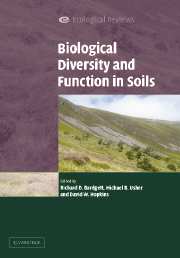Book contents
- Frontmatter
- Contents
- List of contributors
- Preface
- Acknowledgements
- PART I Introduction
- PART II The soil environment
- PART III Patterns and drivers of soil biodiversity
- PART IV Consequences of soil biodiversity
- 10 Microbial community composition and soil nitrogen cycling: is there really a connection?
- 11 Biodiversity of saprotrophic fungi in relation to their function: do fungi obey the rules?
- 12 Is diversity of mycorrhizal fungi important for ecosystem functioning?
- 13 Trophic structure and functional redundancy in soil communities
- 14 Plant–soil feedback and soil biodiversity affect the composition of plant communities
- 15 Response of the soil bacterial community to perturbation
- PART V Applications of soil biodiversity
- PART VI Conclusion
- Index
- References
11 - Biodiversity of saprotrophic fungi in relation to their function: do fungi obey the rules?
Published online by Cambridge University Press: 17 September 2009
- Frontmatter
- Contents
- List of contributors
- Preface
- Acknowledgements
- PART I Introduction
- PART II The soil environment
- PART III Patterns and drivers of soil biodiversity
- PART IV Consequences of soil biodiversity
- 10 Microbial community composition and soil nitrogen cycling: is there really a connection?
- 11 Biodiversity of saprotrophic fungi in relation to their function: do fungi obey the rules?
- 12 Is diversity of mycorrhizal fungi important for ecosystem functioning?
- 13 Trophic structure and functional redundancy in soil communities
- 14 Plant–soil feedback and soil biodiversity affect the composition of plant communities
- 15 Response of the soil bacterial community to perturbation
- PART V Applications of soil biodiversity
- PART VI Conclusion
- Index
- References
Summary
SUMMARY
The mycelia of fungal communities in soil and plant litter are strongly structured by soil horizon and resource availability. Resource quality is important in determining species composition and a certain degree of ‘host’ specificity exists. In soil fungal communities, a few taxa occur much more frequently than the large number of rare ones. The taxa detected are highly dependent on the techniques used. Therefore, it is necessary to cross-reference the information obtained from different methods.
Fungal communities in soil and plant litter are enormously diverse taxonomically, with possibly hundreds of species present in a particular soil horizon. There is still much work to be carried out at the local scale to detect the mycelia of fungi and identify them, together with estimating fungal species richness. Without these initial taxonomic studies, it is impossible subsequently to relate mycelial location and function to species diversity.
Scattered data exist about functional diversity of fungi in soil and plant litter, and there is still far to go before specific fungal decomposer functions are satisfactorily described, especially in the natural environment. Again, a combination of methods is needed. The results of functional tests, especially for ‘key’ species, should be related to community structure.
Are all the possibly hundreds of fungal species present on decomposing plant litter necessary to maintain decomposition rates? There is some evidence for functional redundancy because frequently isolated species have been found to have the same specific enzyme capabilities for decomposition as occasional ones. The idiosyncratic hypothesis may also be supported. The existence of ‘keystone’ species, on which the maintenance of whole ecosystems may rely, suggests that decomposition rate is dependent more on fungal species composition, and its functional repertoire, rather than on simply richness alone.
- Type
- Chapter
- Information
- Biological Diversity and Function in Soils , pp. 189 - 215Publisher: Cambridge University PressPrint publication year: 2005
References
- 3
- Cited by

